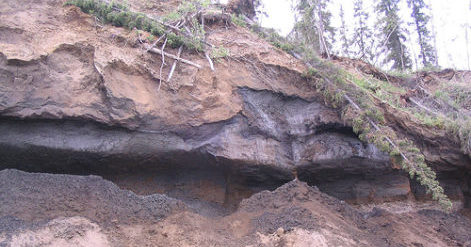
 )
)Recently, we discussed the possibility of bring the woolly mammoth back to life. One of the more ambitious plans involved raising herds of new mammoths to roam the Arctic and punch holes in the upper layers of ice. Those holes would expose deeper permafrost layers to cold air that will reduce thawing. The thermodynamics are plausible for the same reason igloos work as shelter; the air temperature is below freezing, which means that the insulating ice is actually keeping the ground underneath warmer than if it were exposed to the air. But we may need to come up with a more practical plan for achieving the same goal because the permafrost is melting and ancient organisms may be coming back to life: not mammoths, but microbes.
Unlike mammoths, bacteria and viruses can survive frozen for millenia and be revived by thawing. Already there is reason to think that anthrax frozen nearly a century ago recently thawed out and made at least 20 people ill, including one boy who died. Other potential sources of plague, smallpox and anthrax are believed to be frozen in regions at risk of thawing soon. Anthrax and plague bacteria are still with us regardless of what melts, although additional opportunities for exposure are still a health concern. Smallpox has not infected a human in decades and whole generations are susceptible since they weren’t vaccinated. Those are scenarios we can model based on past experience and respond to with proven therapies. The biggest unknown, however, are older layers from mammoth days or even earlier that might harbor microbial species or strains for which we have no prior immunity, no vaccine and no drugs. While ancient bacteria and viruses have been revived on several occasions, freezing is lethal to many microbes, and the extended dormancy will have claimed still more. A new/old disease outbreak is thus a theoretical possibility to be aware of even if the likelihood is challenging to estimate. At the same time, we shouldn’t be distracted from other climate change concerns with greater certainty of creating problems.
It’s also worth noting that the possibilities are not purely dire. There are potential academic opportunities to study new species and possibly learn more about the evolution of bacteria and viruses. More practical possibilities exist as well. The discovery of bacteria in thermal vents led to the identification of a DNA polymerase that could tolerate extreme heat, leading to the development of PCR techniques which revolutionized biology and medicine. PCR facilitates genome sequencing, genetic screening, diagnosis of infectious diseases, tissue typing for transplants, forensics, and a host of other applications. Who knows what other potentially useful proteins have been preserved for us in the ice, perhaps even those traits which made survival in freezing conditions possible. And thanks in part to PCR, we don’t even need living bacteria or viruses to find them; we just need intact DNA. The possibility of finding something useful may also be remote, and any potential benefit wouldn’t offset the other consequences of permafrost melt and climate change in general. I just think we might as well think about and prepare for the positive as well as the negative in this situation.
Andy has worn many hats in his life. He knows this is a dreadfully clichéd notion, but since it is also literally true he uses it anyway. Among his current metaphorical hats: husband of one wife, father of two teenagers, reader of science fiction and science fact, enthusiast of contemporary symphonic music, and chief science officer. Previous metaphorical hats include: comp bio postdoc, molecular biology grad student, InterVarsity chapter president (that one came with a literal hat), music store clerk, house painter, and mosquito trapper. Among his more unique literal hats: British bobby, captain’s hats (of varying levels of authenticity) of several specific vessels, a deerstalker from 221B Baker St, and a railroad engineer’s cap. His monthly Science in Review is drawn from his weekly Science Corner posts — Wednesdays, 8am (Eastern) on the Emerging Scholars Network Blog. His book Faith across the Multiverse is available from Hendrickson.

Leave a Reply